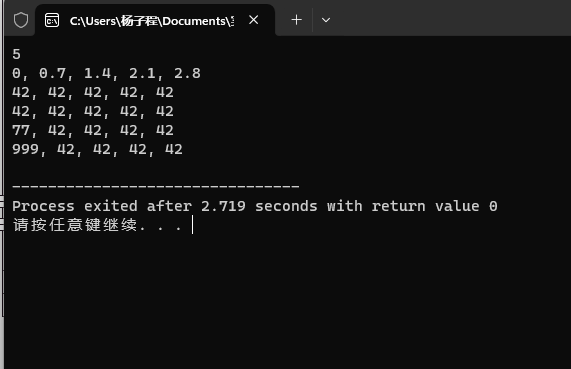实验任务4

#pragma once #include <iostream> #include <stdexcept> using std::cout; using std::endl; template <typename T> class Vector { public: // 构造函数,默认大小为0 Vector(int n = 0) : size(n), data(new T[n]) { if (n < 0) { throw std::length_error("Vector<T> constructor: negative size"); } } // 构造函数,指定大小和初始值 Vector(int n, T value) : size(n), data(new T[n]) { if (n < 0) { throw std::length_error("Vector<T> constructor: negative size"); } for (int i = 0; i < n; ++i) { data[i] = value; } } // 拷贝构造函数(深复制) Vector(const Vector& other) : size(other.size), data(new T[other.size]) { for (int i = 0; i < size; ++i) { data[i] = other.data[i]; } } // 析构函数 ~Vector() { delete[] data; } // 返回数组中元素的个数 int getSize() const { return size; } // 通过索引访问元素 T& at(int index) { validateIndex(index); return data[index]; } const T& at(int index) const { if (index < 0 || index >= size) { throw std::out_of_range("Index out of range"); } validateIndex(index); return data[index]; } // 重载下标操作符 T& operator[](int index) { return at(index); } const T& operator[](int index) const { if (index < 0 || index >= size) { throw std::out_of_range("Index out of range"); } return at(index); } template <typename U> friend void output(const Vector<U>& vec); private: int size; // 数组的当前大小 T* data; // 指向动态分配数组的指针 void validateIndex(int index) const { if (index < 0 || index >= size) { throw std::out_of_range("Index out of range"); } } }; template <typename U> void output(const Vector<U>& vec) { for (int i = 0; i < vec.size; ++i) { cout << vec.data[i] << ", "; } if (vec.size > 0) { cout << "\b\b "; } cout << endl; }

#include <iostream> #include "task4.hpp" void test() { using namespace std; int n; cin >> n; Vector<double> x1(n); for(auto i = 0; i < n; ++i) x1.at(i) = i * 0.7; output(x1); Vector<int> x2(n, 42); Vector<int> x3(x2); output(x2); output(x3); x2.at(0) = 77; output(x2); x3[0] = 999; output(x3); } int main() { test(); }
//收获,了解了三个函数的区别
非常量成员函数 (int& get(int index)):当你需要修改 Vector 中的元素时使用。如果你要更新 Vector 中的某个值,这个合适.
常量引用返回的非常量成员函数 (const int& getConst(int index)):当你需要读取但不修改 Vector 中的元素时提供了一个安全的方式来访问元素,防止不小心修改它们。
常量成员函数 (const int& getConst(int index) const):当你在一个常量(例如在一个接收 const Vector& 参数的函数内)时使用。这确保了即使在这种上下文中,你也能读取 Vector 中的元素,同时保证不会修改 Vector 的状态。

实验任务5

#include <iostream> #include <fstream> #include <iomanip> void output(std::ostream &out) { for (int i = 0; i <=26; ++i) { if (i == 0) { out<<" "; for (char ch = 'a'; ch <= 'z'; ++ch) { out << ch << ' '; } out << '\n'; continue; } out << std::setw(2) << i << ' '; for (int j = 0; j < 26; ++j) { out << char('A' + (j + i ) % 26) << ' '; } out << '\n'; } } int main() { output(std::cout); std::ofstream file_out("cipher_key.txt"); if (file_out.is_open()) { output(file_out); } else { std::cerr << "Error opening the file for writing." << std::endl; } file_out.close(); return 0; }
相比与传统的用两个封装函数void save_to_file(){}和void load_from_file(){}这种编写方式极大的缩减了代码的长度,并且在一开始先用cout传递参数,在显示器输出后面所要保存的文本数据,实现了快速解决问题和要求的能力。但是弊端就是逻辑思路不清晰,没有体现封装的特性。


